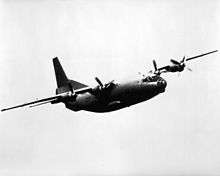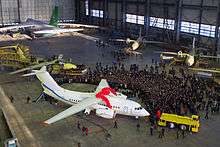Antonov
Antonov State Enterprise (Ukrainian: Державне підприємство "Антонов"),[2] formerly the Aeronautical Scientific-Technical Complex named Antonov (Antonov ASTC) (Ukrainian: Авіаційний науково-технічний комплекс імені Антонова, (АНТК ім. Антонова)), and earlier the Antonov Design Bureau, is a Ukrainian aircraft manufacturing and services company. Antonov's particular expertise is in the fields of very large aeroplanes and aeroplanes using unprepared runways. Antonov (model prefix "An-") has built a total of approximately 22,000 aircraft, and thousands of its planes are currently operating in the former Soviet Union and in developing countries.[3]
 | |
Native name | Державне підприємство "Антонов" |
|---|---|
| State-owned company | |
| Industry | Aerospace and defence |
| Founded | 31 May 1946 |
| Founder | Oleg Antonov |
| Headquarters | , Ukraine |
Key people | Oleksandr Donets (president of the enterprise)[1] |
| Products |
|
Number of employees | 13,700 (2014) |
| Parent | Ukroboronprom |
| Divisions | |
| Website | www.antonov.com |
Antonov StC is a state-owned commercial company. Its headquarters and main industrial grounds were originally located in Novosibirsk, and were later transferred to Kiev.[4] On 12 May 2015 it was transferred from the Ministry of Economic Development and Trade to the Ukroboronprom (Ukrainian Defense Industry).[5]
In June 2016, Ukraine's major state-owned arms manufacturer Ukroboronprom announced the creation of the Ukrainian Aircraft Corporation within its structure, to combine all aircraft manufacturing enterprises in Ukraine.
History
Soviet era

Foundation and relocation
The company was established in 1946 at the Novosibirsk Aircraft Production Association as the top-secret Soviet Research and Design Bureau No. 153 (OKB-153). It was headed by Oleg Antonov and specialised in turboprop military transport aircraft. The task was to create an agricultural aircraft CX-1 (An-2), the first flight of which occurred on August 31, 1947. The An-2 biplane was a major achievement of this period, with hundreds of these aircraft still operating as of 2013.[6] In addition to this biplane and its modifications, a small series of gliders A-9 and A-10 were created and built in the pilot production in Novosibirsk. In 1952, the Bureau was relocated to Kiev, a city with a rich aviation history and an aircraft-manufacturing infrastructure restored after the destruction caused by World War II.
First serial aircraft and expansion
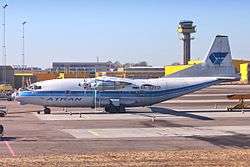
The 1957 introduction of the An-10/An-12 family of mid-range turboprop aeroplanes began the successful production of thousands of these aircraft. Their use for both heavy combat and civilian purposes around the globe continues to the present; the An-10/An-12 were used most notably in the Vietnam War, the Soviet–Afghan War and the Chernobyl disaster relief megaoperation.
In 1959, the bureau began construction of the separate Flight Testing and Improvement Base in suburban Hostomel (now the Antonov Airport).
In 1965, the Antonov An-22 heavy military transport entered serial production to supplement the An-12 in major military and humanitarian airlifts by the Soviet Union. The model became the first Soviet wide-body aircraft, and it remains the world's largest turboprop-powered aircraft. Antonov designed and presented a nuclear-powered version of the An-22. It was never flight tested.
In 1966, after the major expansion in the Sviatoshyn neighbourhood of the city, the company was renamed to another disguise name: "Kiev Mechanical Plant". Two independent aircraft production and repair facilities, under engineering-supervision of the Antonov Bureau, also appeared in Kiev during this period.
Prominence and Antonov's retirement

In the 1970s and early 1980s, the company established itself as the Soviet Union's main designer of military transport aircraft with dozens of new modifications in development and production. After Oleg Antonov's death in 1984, the company was officially renamed as the Research and Design Bureau named after O.K. Antonov (Russian: Опытно-конструкторское бюро имени О.К. Антонова) while continuing the use of "Kiev Mechanical Plant" alias for some purposes.
Late Soviet-era: superlarge projects and first commercialisation

In the late 1980s, the Antonov Bureau achieved global prominence after the introduction of its extra large aeroplanes. The An-124 "Ruslan" (1982) became the Soviet Union's mass-produced strategic airlifter under the leadership of Chief Designer Viktor Tolmachev. The Bureau enlarged the "Ruslan" design even more for the Soviet space shuttle programme logistics, creating the An-225 "Mriya" in 1989. "Mriya" is still the world's largest and heaviest aeroplane.
The end of the Cold War and perestroika allowed the Antonov company's first step to commercialisation and foreign expansion. In 1989, the Antonov Airlines subsidiary was created for its own aircraft maintenance and cargo projects.
Independent Ukraine
Antonov Design Bureau remained a state-owned company after Ukraine achieved its independence in 1991 and is since regarded as a strategic national asset.
Expansion to free market
Since independence, Antonov has certified and marketed both Soviet-era and newly developed models for sale in new markets outside of the former soviet-sphere of influence. New models introduced to serial production and delivered to customers include the Antonov An-140, Antonov An-148 and Antonov An-158 regional airliners.
Among several modernisation projects, Antonov received orders for upgrading "hundreds" of its legendary An-2 utility planes still in operation in Azerbaijan, Cuba and Russia to the An-2-100 upgrade version.[6]
In 2014, following the annexation of the Crimea by Russia, Ukraine cancelled contracts with Russia, leading to a significant income reduction in Ukraine's defense and aviation industries.[7] However Ukraine has been slowly recovering the deficit from breaking ties with Russia by entering new markets and expanding its presence in old ones such as India.[8][9][10][11] [12][13][14]
In July 2018 Antonov was able to secure a deal with Boeing in order to procure airplane parts which were no longer available due to breakdown of relations with Russia.[15]
Production facilities' consolidation
During the Soviet period, not all Antonov-designed aircraft were manufactured by the company itself. This was a result of Soviet industrial strategy that split military production between different regions of the Soviet Union to minimise potential war loss risks. As a result, Antonov aeroplanes were often assembled by the specialist contract manufacturers.
In 2009, the once-independent "Aviant" aeroplane-assembling plant in Kyiv became part of Antonov, facilitating a full serial manufacturing cycle of the company. However, the old tradition of co-manufacturing with contractors is continued, both with Soviet-time partners and with new licensees like Iran's HESA.[16]
In 2014, the Antonov produced and delivered only two An-158 airplanes.[17] This trend continued onto 2015, producing one An-148 and one An-158.[18] In 2016, no aircraft were produced or delivered to clients, though the company has plans to start up production in 2017.[18]
.jpg)
In June 2016, Ukraine's major state-owned arms manufacturer Ukroboronprom announced the creation of the Ukrainian Aircraft Corporation within its structure, thereby combining all aircraft manufacturing enterprises, including the assets of Antonov into a single cluster, according to Ukroboronprom's press service.[19]
On 19 July 2017, the Ukrainian government approved the liquidation of Antonov's assets,[20][21] starting with closing down three factories in Kyiv and Kharkiv.[22] The State Concern "Antonov" (a business group, created in 2005 from the merger of several legally independent companies into a single economic entity under unified management) will be liquidated as a residual corporate entity. Antonov State Company, Kharkiv State Aviation Manufacturing Enterprise and Plant No.410 of Civil Aviation were transferred under the management of another state-owned concern Ukroboronprom in 2015. Antonov State Company continues to function as an enterprise.[23]
Composition
- Antonov Serial Production Plant (formerly Kiev Aviation Factory "Aviant") – Kiev
- Kharkiv Aviation Factory – Kharkiv
- Antonov – Kiev
- Civil Aviation Factory 441 – Kiev
Airfields
- Sviatoshyn Airfield, Aviant factory in Kiev
- Hostomel Airport, freight airport in Hostomel
Products and activities
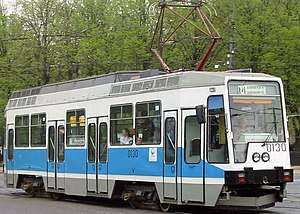
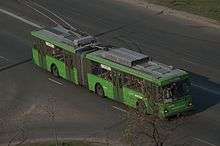
Fields of commercial activity of Antonov ASTC include:
- Aircraft design and manufacturing
- Cargo air transport (Antonov Airlines)
- Aircraft maintenance, testing, certification and upgrading
- Aerospace-related research and engineering
- "Aerial Launch": a joint Russian-Ukrainian project of midair spacecraft space launch from aboard a modified version of the An-225.[24]
- Operation of the Hostomel airport (Antonov Airport)
- Medium-capacity rail transport system RADAN
- Construction of LT-10A trams (with aluminium body)
- Construction and manufacturing of Kiev-12 trolley buses (a spin-off, using existing technical expertise).[25]
Major contractors and partners
Contract and licensee manufacturers
- Tashkent Aviation Production Association (formerly Tashkent State Aviation Plant) – Tashkent, Uzbekistan
- Iran Aircraft Manufacturing Industrial Company (HESA) – Shahin Shahr, Iran[16]
- Voronezh Aircraft Production Association (VASO) – Voronezh, Russia
Chief designers
- Oleg Antonov: 1946–1984
- Petro Balabuiev: 1984–2005
- Dmytro Kiva: since 2005
Aircraft
Antonov's aeroplanes (design office prefix An) range from the rugged An-2 biplane through the An-28 reconnaissance aircraft to the massive An-124 Ruslan and An-225 Mriya strategic airlifters (the latter being the world's heaviest aircraft with only one currently in service). Whilst less famous, the An-24, An-26, An-30 and An-32 family of twin turboprop, high winged, passenger/cargo/troop transport aircraft are important for domestic/short-haul air services particularly in parts of the world once led by communist governments. The An-72/An-74 series of small jetliners is slowly replacing that fleet, and a larger An-70 freighter is under certification.
The Antonov An-148 is a new regional airliner of twin-turbofan configuration. Over 150 aircraft have been ordered since 2007. A stretched version is in development, the An-158 (from 60–70 to 90–100 passengers).
The Antonov/Taqnia An-132 is a twin-engined turboprop under development as of 2018.
| Aircraft | Name | Maiden flight | Remarks |
|---|---|---|---|
| A-40 | Krylaty Tank | 2 September 1942 | Winged tank |
| An-2 | Kukuruznik | 31 August 1947 | multi-purpose, biplane, single-engine utility transport. |
| An-2-100 | Kukuruznik | 10 July 2013 | An-2 upgrade version refitted with Motor Sich kerosene-fueled engine (instead of original avgas).[6] |
| An-3 | 13 May 1980 | turboprop conversion of An-2 | |
| An-4 | 31 July 1951 | float-equipped An-2 | |
| An-6 | Meteo | 21 March 1948 | weather reconnaissance aircraft based on An-2 |
| An-8 | 11 February 1956 | medium military transport | |
| An-10 | Ukraina | 7 March 1957 | medium turboprop-powered airliner |
| An-11 | Motorised variant of the A-11 glider | ||
| An-12 | 16 December 1957 | military turboprop-powered transport, developed from An-10 | |
| An-13 | 1962 | Light aircraft developed from the A-13M motor glider | |
| An-14 | Pchelka | 14 March 1958 | light twin-engine transport |
| An-20 | light turbocharged piston engine aircraft, developed from Cessna 210 | ||
| An-22 | Antei | 27 February 1965 | extremely large turboprop transport |
| An-24 | 20 October 1959 | twin-turboprop airliner | |
| An-26 | 21 May 1969 | twin-turboprop transport, derived from An-24 | |
| An-28 | September 1974 | twin-turboprop light transport, developed from An-14 | |
| An-30 | 21 August 1967 | An-24 adapted for aerial photography and mapping | |
| An-32 | 9 July 1976 | twin-turboprop hot-and-high transport, up-engined An-26 airframe | |
| An-34 | 4 September 1961 | military transport developed from An-24 | |
| An-38 | 23 June 1994 | twin-turboprop light transport, stretched An-28 | |
| An-40 | cancelled | military transport developed from An-12 | |
| An-44 | cargo aircraft project developed from An-24 | ||
| An-50 | cancelled | airliner project, developed from An-24V | |
| An-51 | civil piston utility aircraft | ||
| An-52 | light twin-piston aircraft | ||
| An-70 | 16 December 1994 | large military transport, powered by four propfan engines, to replace An-12 | |
| An-71 | 12 July 1985 | naval AWACS development of An-72 | |
| An-72 | Cheburashka | 31 August 1977 | STOL transport, utilising the Coandă effect |
| An-74 | Cheburashka | 29 November 1983 | civil version of An-72; version with engines below wings is called An-74TK-300[26] |
| An-88 | AWACS project, not completed | ||
| An-91 | Twin-engined cabin monoplane development of Cessna 310 | ||
| An-102 | light agricultural aircraft | ||
| An-122 | further development of An-22 | ||
| An-124 | Ruslan | 26 December 1982 | strategic airlifter; largest aircraft ever mass-produced |
| An-126 | heavy transport aircraft project | ||
| An-132 | 31 March 2017 | transport aircraft based on An-32 | |
| An-140 | 17 September 1997 | short-range turboprop airliner, to replace An-24 | |
| An-148 | 17 December 2004 | regional jet for 68–85 passengers | |
| An-158 | 28 April 2010 | stretched version of An-148 for 99 passengers | |
| An-168 | business variant of An-148 | ||
| An-171 | stretched An-70 | ||
| An-174 | enlarged An-74 with engines below wings | ||
| An-178 | 7 May 2015 | military transport based on the An-158 | |
| An-180 | cancelled | medium propfan airliner, around 175 passengers | |
| An-181 | Handiwork | experimental aircraft | |
| An-188 | transport aircraft based on An-70 | ||
| An-218 | cancelled | propfan- or turbofan-powered widebody airliner | |
| An-225 | Mriya | 21 December 1988 | An-124 derived strategic airlifter; largest aircraft ever built; only one has been put into service |
| An-318 | cancelled | A planned trijet to compete with The Dc-10 and L-1011 tristar[27] | |
| An-325 | cancelled | planned improvement of An-225 | |
| An-418 | cancelled | A planned airliner version of the An-124 that could compete with the Airbus A380[28] | |
| An-714 | 20 October 1970 | modification of An-14 with air cushion landing gear | |
| GPS | small twin-engined utility transport | ||
| OKA-38 | Aist | Copy of Fieseler Fi 156 | |
| Li-2V | high-altitude research aircraft, converted from Lisunov Li-2 | ||
| SKV | Partizanskii | Basis for An-14 | |
| T-2M | Maverick | ultralight trike for recreational club use and special forces requirements | |
| VP | Utka | experimental air trailer (tow glider) | |
Gliders

| Aircraft | Name | Maiden flight | Remarks |
|---|---|---|---|
| A-1 | 1930 | single-seat training glider | |
| A-2 | 1936 | two-seat training glider derived from the A-1 | |
| A-3 | Molodv | ||
| A-6 | |||
| A-7 | 1942 | military glider | |
| A-9 | 1948 | single-seat sailplane developed from the RF-7 | |
| A-10 | 1952 | two-seat sailplane developed from the A-9 | |
| A-11 | 12 May 1958 | ||
| A-13 | 1958 | ||
| A-15 | 26 March 1960 | ||
| BS-3 | 1934 | training glider | |
| BS-4 | 1935 | training glider | |
| BS-5 (OKA-31) | 1936 | training glider | |
| DIP (OKA-14) | Dognat i peregna | 1932 | record glider developed from OKA-6 |
| IP | |||
| LEM-2 (OKA-37) | 1937 | motor glider | |
| M-1 | 1933 | ||
| M-2 | |||
| M-3 (OKA-24) | 1934 | ||
| M-4 (OKA-29) | |||
| M-5 (OKA-30) | 1936 | ||
| OKA-1 | Golub | 1924 | |
| OKA-2 | 1925 | ||
| OKA-3 | 1928 | ||
| OKA-5 | Standard-2 | 1930 | |
| OKA-6 | Gorod Lenina | 1930 | |
| OKA-7 | Bubik | 1930 | |
| OKA-13 | Chest Uslovii Stalina | 1932 | |
| OKA-21 | 1933 | training glider based on DIP | |
| PS-1 (OKA-11) | training glider | ||
| PS-2 (OKA-12) | training glider | ||
| RF-1 (OKA-17) | 1933 | ||
| RF-2 (OKA-18) | 1933 | ||
| RF-3 (OKA-19) | 1933 | ||
| RF-4 (OKA-20) | 1933 | ||
| RF-5 (OKA-23) | 1934 | ||
| RF-6 (OKA-28) | |||
| RF-7 | 1937 | sports glider | |
| RF-8 | 1941 | troop glider, enlarged RF-7; redesignated A-7 | |
| US-1 | 1931 | training glider | |
| US-2 | 1931 | training glider | |
| US-3 | 1932 | training glider, first mass-produced Soviet glider | |
| US-4 | training glider, redesignated A-1 | ||
| US-5 (OKA-32) | 1936 | training glider | |
| US-6 | training glider, redesignated A-2 |
References
- Ukraine's Antonov to build up to 10 aircraft in five years, UNIAN (4 July 2018)
- "Antonov state enterprise to renew production of Ruslan aircraft in 2019".
- "About the Company". www.antonov.com. Archived from the original on 27 February 2018. Retrieved 29 June 2017.CS1 maint: BOT: original-url status unknown (link)
- "Contacts"Archived 21 February 2011 at the Wayback Machine. Retrieved on 5 February 2011.
- Cabinet of Ukraine gave Antonov to Ukroboronprom. Ukrinform. 12 May 2015
- Россия заказала у Антонова усовершенствованные кукурузники. Korrespondent (in Russian). 11 July 2013. Retrieved 4 September 2013.
- Nicolai Petro (9 March 2016). "Why Ukraine needs Russia more than ever". The Guardian. Retrieved 7 September 2016.
- https://economics.unian.info/10084925-ukraine-u-s-winning-indian-defense-market-over-russia-official.html
- https://www.janes.com/article/81136/ukraine-thailand-look-to-establish-joint-industrial-facility
- http://www.defenseworld.net/interview/106/Ukraine_to_Pitch_for_Repair__Components_Supply_of_USSR_Origin_Aircraft_in_India
- http://www.defenseworld.net/news/20458/Ukraine_Discusses_Cooperation_With_UAE_in_Guided_Weapons__UAVs
- https://www.kyivpost.com/ukraine-politics/ukraine-preparing-for-boosting-defense-cooperation-with-africa-in-aircraft-repair-area.html
- https://www.defensenews.com/global/europe/2018/07/27/turkey-ukraine-advance-an-188-co-production-talks/
- https://www.arabianaerospace.aero/new-saudi-ukrainian-aircraft-programme-launched.html
- https://www.reuters.com/article/us-ukraine-boeing-antonov/ukraine-plane-maker-turns-west-with-boeing-tie-up-idUSKBN1KH0OM
- "ANTONOV history". www.antonov.com. Archived from the original on 27 February 2018. Retrieved 29 June 2017.CS1 maint: BOT: original-url status unknown (link)
- "ГП "Антонов" подвел итоги 2014 года: Только два новых самолета". Retrieved 29 June 2017.
- "Андрей Хаустов: "Появился шанс, что вторая "Мрия" обретет свою жизнь в небе"". Archived from the original on 12 September 2016. Retrieved 29 June 2017.
- "UNIAN News. Latest news of Ukraine and world". uatoday.tv. Retrieved 29 June 2017.
- "Cabinet of Ministers liquidates Concern Antonov - 25.07.2017 17:39 — Ukrinform News". Retrieved 27 July 2017.
- "The Cabinet of Ministers has decided to liquidate State Aircraft Manufacturing Concern Antonov". Ukrinform. 26 July 2017. Retrieved 26 July 2017.
- Kitsoft. "Cabinet of Ministers of Ukraine - Government approved technical decision to liquidate the Antonov Corporate Group and to finalize the steps undertaken earlier to restructure the aircraft industry". www.kmu.gov.ua. Retrieved 27 November 2019.
- "Following the recent announcement from the Government of Ukraine". antonov.com. Antonov State Company. Archived from the original on 27 February 2018.CS1 maint: BOT: original-url status unknown (link)
- Правительство задумалось о "Воздушном старте". Interfax (in Russian). 23 April 2013. Retrieved 29 April 2013.
- "Antonov Ground Transport". Archived from the original on 27 February 2018. Retrieved 10 January 2009.
- "Aviation Photo Search". Airliners.net. Retrieved 29 June 2017.
- "Antonov An-318". www.globalsecurity.org. Retrieved 21 December 2019.
- "Antonov An-418". www.globalsecurity.org. Retrieved 21 December 2019.
Further reading
- MacFarquhar, Neil. "Aviation Giant Is Nearly Grounded in Ukraine." The New York Times. 12 October 2014. Corrected on 12 October 2014.
External links
| Wikimedia Commons has media related to Antonov. |
- Antonov company site
- Antonov company site (in Russian)
